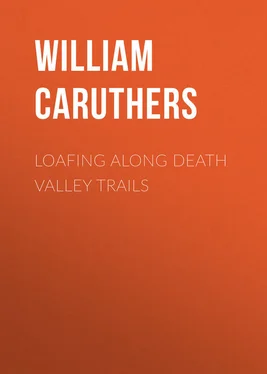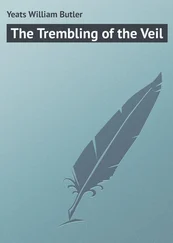William Caruthers - Loafing Along Death Valley Trails
Здесь есть возможность читать онлайн «William Caruthers - Loafing Along Death Valley Trails» — ознакомительный отрывок электронной книги совершенно бесплатно, а после прочтения отрывка купить полную версию. В некоторых случаях можно слушать аудио, скачать через торрент в формате fb2 и присутствует краткое содержание. Жанр: foreign_language, foreign_prose, на английском языке. Описание произведения, (предисловие) а так же отзывы посетителей доступны на портале библиотеки ЛибКат.
- Название:Loafing Along Death Valley Trails
- Автор:
- Жанр:
- Год:неизвестен
- ISBN:нет данных
- Рейтинг книги:5 / 5. Голосов: 1
-
Избранное:Добавить в избранное
- Отзывы:
-
Ваша оценка:
- 100
- 1
- 2
- 3
- 4
- 5
Loafing Along Death Valley Trails: краткое содержание, описание и аннотация
Предлагаем к чтению аннотацию, описание, краткое содержание или предисловие (зависит от того, что написал сам автор книги «Loafing Along Death Valley Trails»). Если вы не нашли необходимую информацию о книге — напишите в комментариях, мы постараемся отыскать её.
Loafing Along Death Valley Trails — читать онлайн ознакомительный отрывок
Ниже представлен текст книги, разбитый по страницам. Система сохранения места последней прочитанной страницы, позволяет с удобством читать онлайн бесплатно книгу «Loafing Along Death Valley Trails», без необходимости каждый раз заново искать на чём Вы остановились. Поставьте закладку, и сможете в любой момент перейти на страницу, на которой закончили чтение.
Интервал:
Закладка:
In 1861 Lt. Ives on a surveying mission explored a part of the valley in connection with the California Boundary Commission. He used for pack animals some of the camels which had been provided by Jefferson Davis, Secretary of War, for transporting supplies across the western deserts.
In 1861 Dr. S. G. George, who had been a member of French’s party, organized one of his own and for the same reason – to find the Lost Gunsight. He made several locations of silver and gold, explored a portion of the Panamint Range. The first man ever to scale Telescope Peak was a member of the George party. He was W. T. Henderson, who had also been with Dr. French. Henderson named the mountain “because,” he said, “I could see for 200 miles in all directions as clearly as through a telescope.”
The most enduring accomplishment of the party was to bring back a name for the mountain range east of what is now known as Owens Valley, named for one of Fremont’s party of explorers. From an Indian chief they learned this range was called Inyo and meant “the home of a Great Spirit.” Ultimately the name was given to the county in the southeast corner of which is Death Valley.
Tragedy dogged all the early expeditions. July 21, 1871 the Wheeler expedition left Independence to explore Death Valley. This party of 60 included geologists, botanists, naturalists, and soldiers. One detachment was under command of Lt. George Wheeler. Lt. Lyle led the other. Lyle’s detachment was guided by C. F. R. Hahn and the third day out Hahn was sent ahead to locate water. John Koehler, a naturalist of the party is alleged to have said that he would kill Hahn if he didn’t find water. Failing to return Hahn was abandoned to his fate and he was never seen again.
William Eagan, guide of Wheeler’s party was sent to Rose Springs for water. He also failed to return. What became of him is not known and the army officers were justly denounced for callous indifference. On the desert, inexcusable desertion of a companion brands the deserter as an outcast and has often resulted in his lynching.
It is interesting to note that apart from a Government Land Survey in 1856, which proved to be utterly worthless, there is no authentic record of the white man in Death Valley between 1849 and 1860. However, during this decade the canyons on the west side of the Panamint harbored numerous renegades who had held up a Wells-Fargo stage or slit a miner’s throat for his poke of gold. Some were absorbed into the life of the wasteland when the discovery of silver in Surprise Canyon brought a hectic mob of adventurers to create hell-roaring Panamint City.
When, in the middle Seventies Nevada silver kings, John P. Jones and Wm. R. Stewart, who were Fortune’s children on the Comstock, decided $2,000,000 was enough to lose at Panamint City, many of the outlaws wandered over the mountain and down the canyon to cross Death Valley and settle wherever they thought they could survive on the eastern approaches.
Soon Ash Meadows, Furnace Creek Ranch, Stump Springs, the Manse Ranch, Resting Springs, and Pahrump Ranch became landmarks.
The first white man known to have settled in Death Valley was a person of some cunning and no conscience, known as Bellerin’ Teck, Bellowing Tex Bennett, and Bellowin’ Teck. He settled at Furnace Creek in 1870 and erected a shanty alongside the water where the Bennett-Arcane party had camped when driven from Ash Meadows by Indians whose gardens they had raided and whose squaws they had abused, according to a legend of the Indians and referred to with scant attention to details, by Manly. (Panamint Tom, famed Indian of the region, in speaking of this raid by the whites, told me that the head man of his tribe sent runners to Ash Meadows for reinforcements and that the recruits were marched in circles around boulders and in and out of ravines to give the impression of superior strength. This strategy deceived the whites, who then went on their way.)
Teck claimed title to all the country in sight. Little is known of his past, but whites later understood that he chose the forbidding region to outsmart a sheriff. He brought water through an open ditch from its source in the nearby foothills and grew alfalfa and grain. He named his place Greenland Ranch and it was the beginning of the present Furnace Creek Ranch.
There is a tradition that Teck supplemented his meager earnings from the ranch by selling half interests to wayfarers, subsequently driving them off.
There remains a record of one such victim – a Mormon adventurer named Jackson. In part payment Teck took a pair of oxen, Jackson’s money and his only weapon, a rifle. Shortly Teck began to show signs of dissatisfaction. His temper flared more frequently and Jackson became increasingly alarmed. When finally Teck came bellowing from his cabin, brandishing his gun, Jackson did the right thing at the right moment. He fled, glad to escape with his life.
This became the pattern for the next wayfarer and the next. Teck always craftily demanded their weapons in the trade, but knowing that sooner or later some would take their troubles to a sheriff or return for revenge, Teck sold the ranch, left the country and no trace of his destiny remains.
Before Aaron and Rosie Winters or Borax Smith ever saw Death Valley, one who was to attain fame greater than either listed more than 2000 different plants that grew in the area.
Notwithstanding this important contribution to knowledge of the valley’s flora, only one or two historians have mentioned his name, and these in books or periodicals long out of print.
Two decades later he was to become famous as Brigadier General Frederick Funston of the Spanish-American War – the only major war in America’s history fought by an army which was composed entirely of volunteers without a single draftee.
Of interest to this writer is the fact that he was my brigade commander and a soldier from the boots up. Not five feet tall, he was every inch a fighting man. I served with him while he captured Emilio Aguinaldo, famous Filipino Insurrecto .
Chapter III
Aaron and Rosie Winters
While Bellerin’ Teck was selling half interests in the spectacular hills to the unwary, he actually walked over a treasure of more millions than his wildest dreams had conjured.
Teck’s nearest neighbor lived at Ash Meadows about 60 miles east of the valley.
Ash Meadows is a flat desert area in Nevada along the California border. With several water holes, subterranean streams, and abundant wild grass it was a resting place for early emigrants and a hole-in for prospectors. It was also an ideal refuge for gentlemen who liked its distance from sheriffs and the ease with which approaching horsemen could be seen from nearby hills.
Lacking was woman. The male needed the female but there wasn’t a white woman in the country. So he took what the market afforded – a squaw and not infrequently two or three. “He’s my son all right,” a patriarch once informed me, “but it’s been so long I don’t exactly recollect which of them squaws was his mother.”
Usually the wife was bought. Sometimes for a trinket. Often a horse. Among the trappers who first blazed the trails to the West, 30 beaver skins were considered a fair price for an able bodied squaw. She was capable in rendering domestic service and loyal in love. Too often the consort’s fidelity was transient.
“For 20 years,” said the noted trapper, Killbuck, “I packed a squaw along – not one, but a many. First I had a Blackfoot – the darndest slut as ever cried for fo-farrow. I lodge-poled her on Coulter’s Creek … as good as four packs of beaver I gave for old Bull-tail’s daughter. He was the head chief of the Ricaree. Thar wan’t enough scarlet cloth nor beads … in Sublette’s packs for her … I sold her to Cross-Eagle for one of Jake Hawkins’ guns… Then I tried the Sioux, the Shian (Cheyenne) and a Digger from the other side, who made the best moccasins as ever I wore.”
Читать дальшеИнтервал:
Закладка:
Похожие книги на «Loafing Along Death Valley Trails»
Представляем Вашему вниманию похожие книги на «Loafing Along Death Valley Trails» списком для выбора. Мы отобрали схожую по названию и смыслу литературу в надежде предоставить читателям больше вариантов отыскать новые, интересные, ещё непрочитанные произведения.
Обсуждение, отзывы о книге «Loafing Along Death Valley Trails» и просто собственные мнения читателей. Оставьте ваши комментарии, напишите, что Вы думаете о произведении, его смысле или главных героях. Укажите что конкретно понравилось, а что нет, и почему Вы так считаете.












